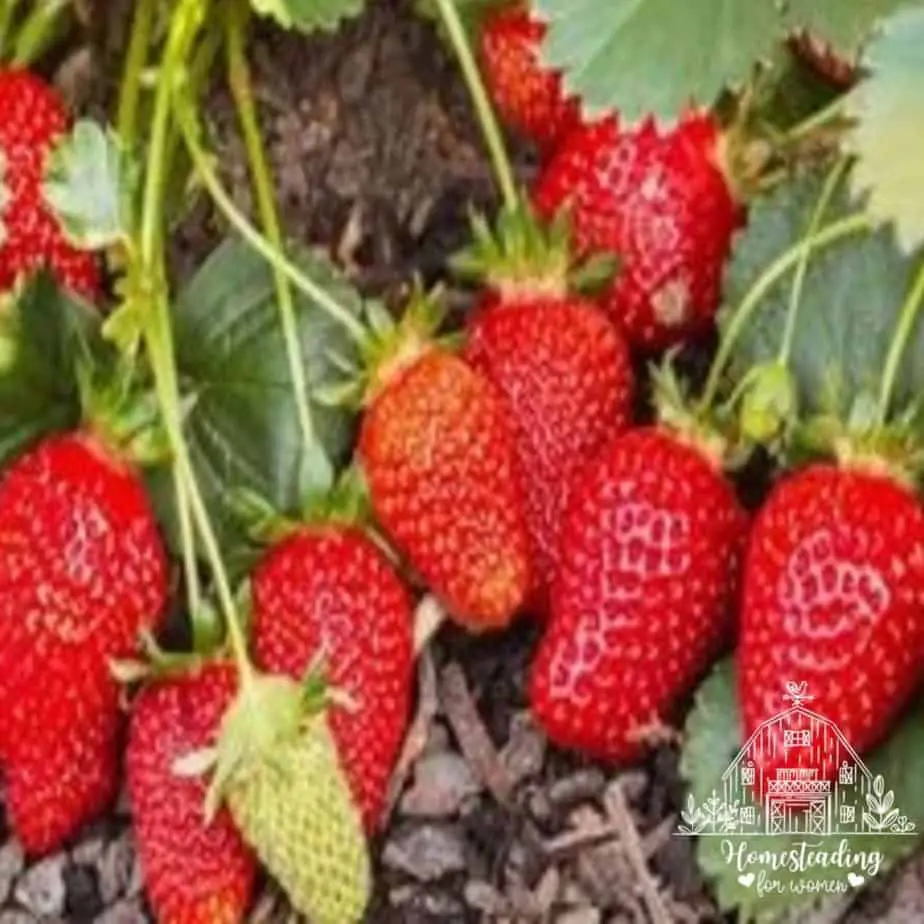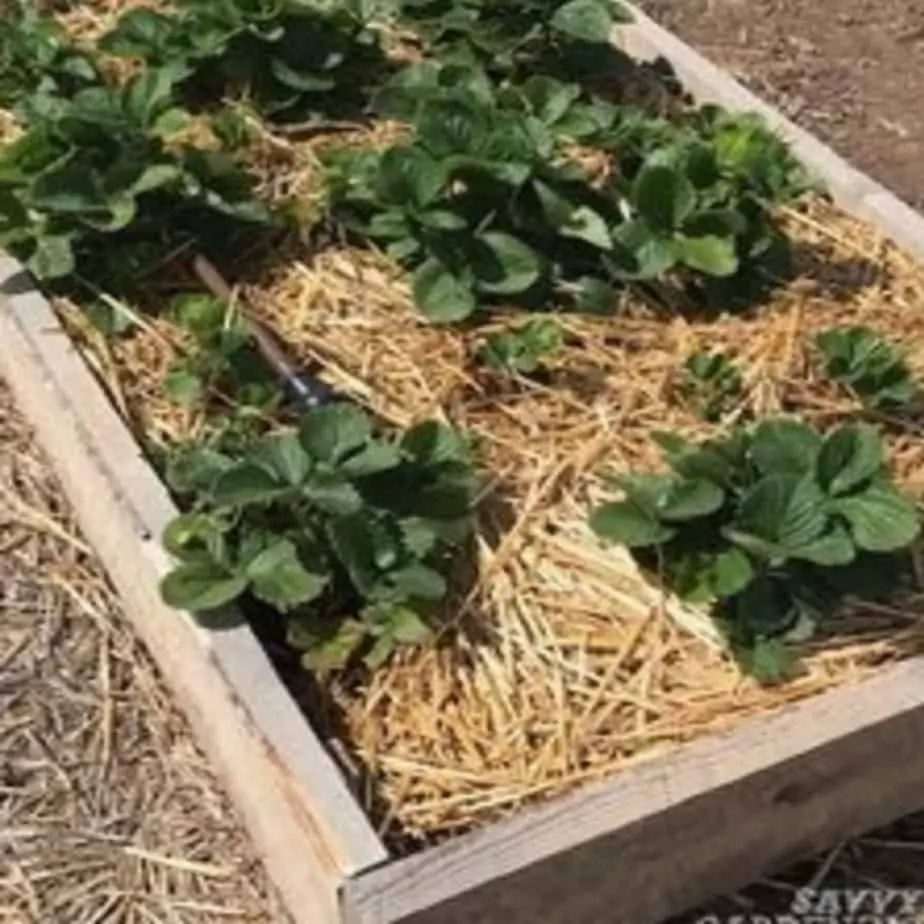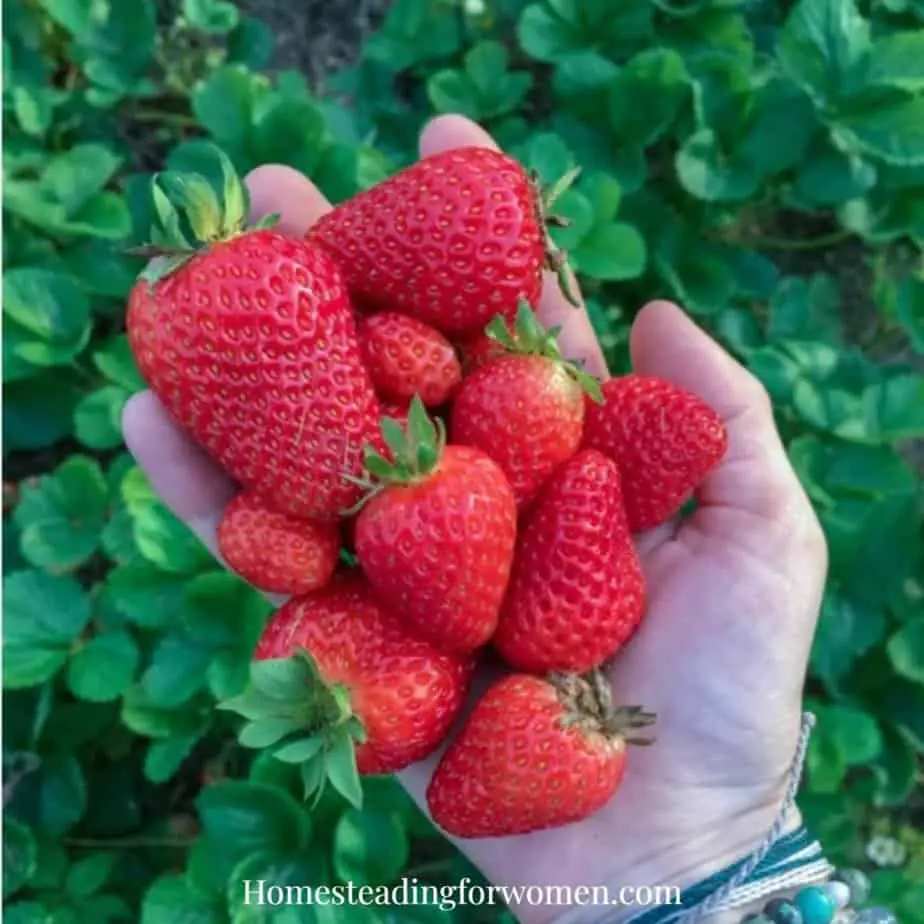Welcome to Homesteading For Women – we hope you enjoy all our tips and tricks for homestead women! Please note that we use affiliate links and ads to generate income at no cost to you.
I’m thinking of starting a strawberry patch this year, so we’re going to look at the top strawberry gardening mistakes and how to keep our berries thriving instead of dying.
Growing strawberries can be a delightful and rewarding experience for any gardener. However, it’s not without its challenges. Even the most attentive gardeners can inadvertently make mistakes that compromise their strawberry plants’ health and productivity.

I want to find out first what mistakes are usually made when growing strawberries and avoid them at all costs. This begins with understanding the needs of strawberry plants, from the moment you select the variety to plant through to the care they require throughout their growth and into harvest.
Ok, let’s do this!
A successful strawberry patch begins long before the first berries ripen. It requires thoughtful preparation, choosing the right varieties for your climate and care, and a strategic approach to planting.
So, I need to do some planning first, got it!
Throughout the life of your strawberry plants, consistent care is key, including proper watering, fertilization, and diligent pest and disease management.
Even at the end of the season, the way you harvest and store your strawberries can make a significant difference in the quality and longevity of your fruit.
Strawberry Gardening Mistakes Key Takeaways
- So I need to pick the right variety and prepare the soil correctly so I will have a good foundation for a thriving strawberry patch.
- Effective planting strategies, watering, and fertilization are critical for the health and yield of strawberry plants.
- Regular maintenance, careful harvesting, and proper storage are essential for preserving strawberry quality.
The following are some of the top strawberry gardening mistakes that gardeners make.

Welcome to Homesteading For Women – we hope you enjoy all our tips and tricks for homestead women! Please note that we use affiliate links and ads to generate income at no cost to you.
1 Choosing the Right Strawberry Varieties
Selecting suitable strawberry varieties is crucial for a successful harvest. Gardeners must consider their local climate and the disease resistance of the strawberry varieties they intend to plant. This is a common mistake gardeners make when they decide to plant strawberries.
I do know that I want the variety that gives fruit in the Spring and not the kind that will have fruit all growing season. We’ll look at some more varieties in a moment.
2 Ignoring Local Climate
Strawberries thrive under specific climatic conditions, and choosing a variety that is not compatible with your local weather can lead to poor yields.
For instance, ‘Honeoye’ performs well in cooler climates, while ‘Chandler’ is suited for warmer regions. Here’s a quick reference for appropriate varieties based on climate zones:
- Cool Climates: ‘Fort Laramie’, ‘Honeoye’
- Temperate Climates: ‘Allstar’, ‘Surecrop’
- Warm Climates: ‘Chandler’, ‘Sweet Charlie’
3 Overlooking Disease Resistance
Disease-resistant strawberry varieties reduce the need for chemical treatments and can minimize losses due to infections. It’s essential to choose varieties with natural resistance to common diseases in your area.
Here are some examples of disease-resistant strawberry varieties:
Disease Resistant Varieties
- Verticillium Wilt ‘Delmarvel’, ‘Seascape’
- Red Stele ‘Earliglow’, ‘Allstar’
- Powdery Mildew ‘Monterey’, ‘San Andreas’
By paying close attention to these factors, gardeners increase their chances of enjoying a bountiful and healthy strawberry crop.
4 Preparing the Soil
Proper soil preparation is crucial for a thriving strawberry garden, as it sets the foundation for plant growth and fruit production.
Neglecting Soil Testing
Before planting strawberries, one must test the soil. This reveals nutrient deficiencies and allows for appropriate adjustments. Neglecting this step can lead to a suboptimal growing environment, affecting plant health.
Using Incorrect Soil pH
Strawberries thrive in soil with a pH between 5.5 and 6.8. Utilizing soil that is too acidic or alkaline can hinder nutrient absorption. One should amend the soil accordingly to maintain the correct pH range.
Failing to Enrich Soil
If you want your strawberries to flourish, the soil should be rich in organic matter. Adding compost or well-rotted manure increases fertility and improves soil structure. Absence of soil enrichment can result in poor plant vitality and yield.
5 Strawberry Planting Strategies
When planting strawberries, timing, spacing, and planting depth are crucial to the success of your garden.
Planting at Wrong Time
Strawberries thrive when planted at the right time. In colder climates, they should be planted in early spring as soon as the soil is workable.
For warmer regions, late fall is ideal. Planting strawberries outside these timeframes can lead to poor establishment and reduced yields.
Incorrect Spacing
Spacing is key for allowing plant growth and airflow.
- Too close:
- Increased disease risk.
- Lower yield.
- Too far apart:
- Wasted space.
- Weeds can become an issue.
Aim for approximately 18 inches between plants and 4 feet between rows.
Planting Depth Errors
The planting depth of strawberry plants should be precise.
- Too deep:
- Crown rot.
- Plant death.
- Too shallow:
- Roots dry out.
- The plant becomes unstable.
Ensure the middle of the crown is level with the soil surface and roots are spread out and fully covered.
6 Watering Techniques
Effective watering strategies are essential for healthy strawberry plants. They aid in promoting deep-root growth, preventing disease, and ensuring ample fruit production.
Overwatering
My grandma used to say, “Strawberries like plenty of water, but they don’t like their feet wet”.
Overwatering can lead to several issues in strawberry plants, including root rot and fungal diseases. Strawberry plants require well-draining soil to avoid water-logging. A practical approach includes:
- Frequency: Water the plants only when the top inch of the soil is dry.
- Amount: Aim for about one to two inches of water per week, depending on weather conditions.
Underwatering
Conversely, under-watered strawberry plants can become dehydrated, leading to wilted leaves and poor fruit yield. Strawberries have shallow root systems that need consistent moisture. To avert under-watering:
- Check Soil Moisture: Use your finger to test soil moisture regularly.
- Mulch: Applying mulch helps retain soil moisture and maintain even soil temperatures.
Inconsistent Watering Schedule
An erratic watering schedule can stress strawberry plants, affecting growth and berry size. They thrive on regularity. To maintain a consistent watering schedule:
- Timers: Consider installing a timer on your irrigation system for regular watering.
- Morning Watering: Watering in the early morning reduces evaporation and disease risk.
7 Fertilization Practices
Appropriate fertilization is crucial for the health and productivity of strawberries. Missteps in this area can lead to poor plant performance or even damage.
Overfertilizing
Overfertilizing can lead to excessive leaf growth, weak fruit, and increased susceptibility to diseases. Strawberry plants should typically receive:
- Pre-planting: A balanced 10-10-10 fertilizer at a rate of 1 pound per 100 square feet.
- During growth: Nitrogen-based fertilizer, but not more than 1 pound of actual nitrogen per 1,000 square feet during the growing season.
Signs of overfertilization include dark green leaves, few flowers, or small fruits.
Underfertilizing
Underfertilizing causes slow growth and poor fruit development. It’s important to ensure:
- Even distribution of fertilizer during application.
- Adequate application based on soil test recommendations, aiming for a balance that supports both vegetative growth and fruit production.
Symptoms to look for include light green to yellow leaves and stunted growth.
Ignoring Nutrient Balance
Ignoring the balance of nutrients in the soil can inhibit plant growth and fruit quality. Strawberry plants need a balance of:
- Nitrogen (N), for leaf growth.
- Phosphorus (P), for root and flower development.
- Potassium (K), for overall plant health.
Regular soil tests are recommended to monitor nutrient levels and pH to maintain a conducive growing environment.
8 Pest and Disease Management
Effective pest and disease management is crucial for the health of strawberry plants. It ensures a bountiful harvest and can prevent the spread of harmful organisms.
Lack of Monitoring
Regular monitoring is essential to detect early signs of pests or diseases. Strawberry growers should inspect their plants weekly, taking note of any changes such as:
- Leaf Discoloration: Yellowing or browning leaves may indicate an issue.
- Holes in Leaves or Fruits: These are often signs of insect feeding.
- Evidence of Slugs or Snails: Slimy trails or chewed fruit and foliage.
Improper Treatment Application
Using the correct treatments for pests and diseases means following specific guidelines:
- Read Labels Carefully: Incorrect dosages or using the wrong treatment can harm plants and be ineffective.
- Application Timing: Treatments should coincide with pest and disease life cycles for maximum effectiveness.
- Safety Precautions: Wear appropriate protective equipment and avoid spraying on windy days to prevent drift to non-target areas.
Not Using Mulch for Protection
Mulch can serve as a protective barrier, and its benefits include:
- Moisture Retention: Helps maintain even soil moisture, which is less conducive to certain fungal diseases.
- Pathogen Barrier: Provides a physical barrier between the fruit and the soil, reducing the risk of soil-borne diseases.
- Weed Suppression: Reduces the habitat for insects that may use weeds as a shelter or alternate host plants.

9 Maintenance and Care
Proper maintenance and care are crucial for a thriving strawberry garden. They will discuss key practices such as pruning, runner control, and winter protection.
Neglecting Pruning
Regular pruning is essential for keeping strawberry plants healthy and productive. One should remove old and dead leaves to minimize disease risk and allow for better air circulation. It’s also beneficial to thin out overcrowded plants to ensure they have enough space to grow.
Ignoring Runners Control
Strawberry plants produce runners that can easily overtake a garden if not managed. They should limit the number of runners per plant to encourage larger, more quality fruit. Utilize a strategy to either snip off excess runners or root them in desired areas.
Overlooking Winter Protection
In areas where winters are cold, strawberry plants need protection to survive the freezing temperatures.
Mulching with straw or pine needles helps insulate the plants. Make sure to apply mulch after the first few frosts to protect the crowns from cold injury.

10 Harvesting and Storage
When it comes to strawberries, timing and technique are everything. A successful harvest hinges on picking at the optimum moment and handling the fruits carefully thereafter.
Harvesting at Wrong Time
Strawberries are best harvested when they are fully red, with no green or white areas. Picking them too early results in fruits lacking in both flavor and nutrients, while picking them too late can lead to overripe, mushy berries that spoil quickly.
They should be picked in the morning when they are still cool and immediately removed from the sun to preserve freshness.
- Optimal Ripeness: Full red color, firm to the touch.
- Harvest Time: Morning hours or when berries are cool.
Improper Handling and Storage
After harvesting, strawberries must be handled with care to prevent bruising and damage. They should be kept cool and dry and not washed until right before use to avoid mold and spoilage.
Storage Instructions:
- Temperature: Store at 32°F (0°C) to 36°F (2.2°C).
- Moisture: Use ventilated containers to allow air circulation.
- Shelf Life: Consume within 3 days for best quality, longer storage may reduce flavor and texture.
- Washing: Only wash just before consuming or using in recipes.
Frequently Asked Questions
In this section, you’ll find straightforward solutions to common strawberry gardening queries, ensuring a smoother gardening experience.
What are some common errors to avoid for thriving strawberry plants?
One often sees gardeners overwatering or planting strawberries where they receive insufficient sunlight.
Strawberries need full sun and well-drained soil to prevent root rot and fungal diseases.
Overcrowding is another misstep, as it limits air circulation and nutrient availability.
How should you handle the initial flowers on newly planted strawberry plants?
For newly planted strawberry plants, it is advisable to remove the initial flowers.
This action encourages them to dedicate energy to establishing strong roots and foliage, which supports better fruit production in subsequent seasons.
One lady told me to never let your new strawberry plants grow any fruit the first year so that your plants will grow strong roots and give you a bountiful harvest the second year. She said she couldn’t wait, so she let her plants fruit that first year, and she never got a good harvest from them.
So I won’t make that mistake.
Which companion plants should be avoided when planting strawberries?
Strawberries should not be planted near members of the cabbage family, such as broccoli and cauliflower, nor with plants that attract similar pests, like tomatoes. Such companions can foster disease spread and increased pest activity.
What are the ideal conditions for growing large and healthy strawberries?
Strawberries flourish in well-draining soil with a pH between 5.5 and 6.8. They require at least six to eight hours of full sunlight per day. Consistent moisture and regular feeding with balanced fertilizer are vital, but avoid waterlogging the roots.
Can you have too many leaves on your strawberry plants, and what should you do about it?
An excess of leaves can hinder fruit production. Pruning excessive foliage helps to improve air circulation and sunlight exposure. One should remove old, yellow, or diseased leaves to prioritize energy for fruit-bearing shoots.
What’s the best type of planter or container for strawberry cultivation?
The best planters for strawberries offer ample drainage and are deep enough to accommodate the roots. Tiered planters, hanging baskets, and grow bags work well because they prevent soil-borne diseases and allow for optimal root spread.

Conclusion
To avoid the top strawberry gardening mistakes one should…
- Choose the right variety for your location
- Choose whether you want your strawberries to produce a lot of fruit at one time or over the course of several months. (You won’t get as many berries with the latter.
- Watering, remember strawberries like water but they don’t want their feet wet.
- Sun, those guys want plenty of sun.
- Don’t plant next to some plants or they will get bugs from them and disease. Better off starting your patch out in the middle of your yard.
- Keep them warm in the winter with straw.
- Don’t let your new strawberry plants bear fruit the first year.
If you follow the guild I created above you should have a wonderful strawberry patch that will provide you with delicious strawberries that you can enjoy with your family and share with your friends. Yum!
You Might Also Like To Read:
Old Bathtub Garden Ideas
What Kind Of Gardens Are There?
Best Sun Hat For Gardening
- Caring for Aging Parents: What I’ve Learned the Hard Way (And Why I’m Planning Ahead Now) - August 4, 2025
- 7 Must Get Beginner Herbal Books For Your Library - July 30, 2025
- What to Have Ready When the Power Goes Out (Even at 6AM!) - July 27, 2025

